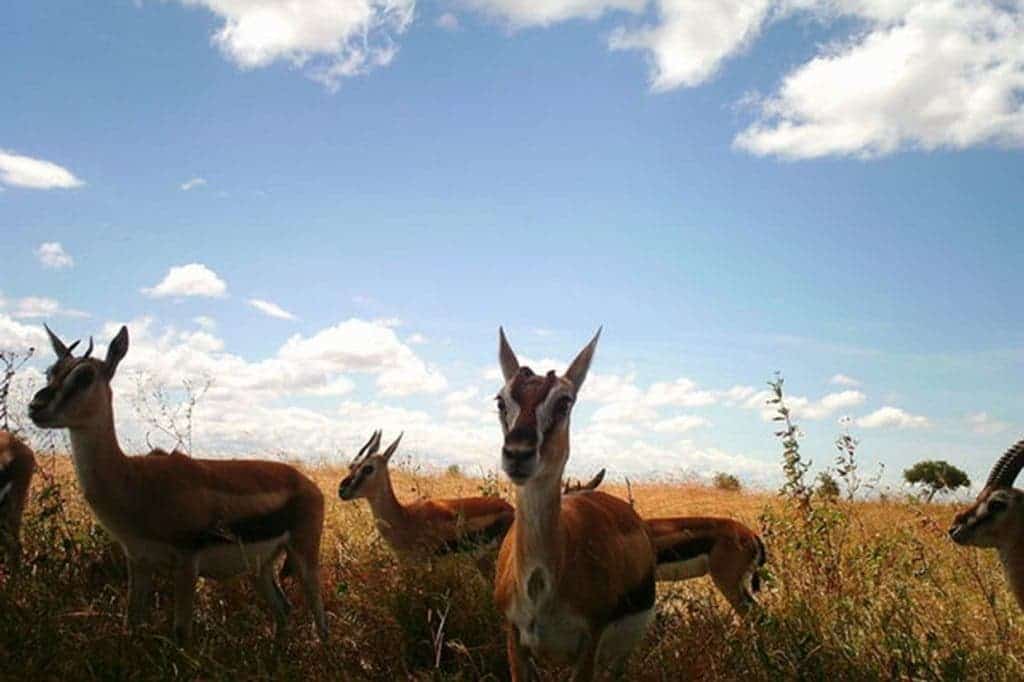After placing no less than 225 camera traps, a group of researchers has collected a massive database of 1.2 million photos documenting the secret live of the animals that roam Tanzania’s Serengeti National Park. The shots offer a raw, unedited glimpse that wouldn’t had been possible otherwise; genuinely up close and personal. So personal that some of the lions and other beasrs in the park went a step too far and tried to eat the cameras. At time, the only thing that was left of the camera was plastic shreds, but luckily some memory cards survived. How often do you get to see the last shot made by a camera? With a lion with a fully open jaws staring right at you, no less.

Tanzania’s Serengeti National Park is home to one of the biggest and most complex ecosystem in the world. It’s also one of the most spectacular, especially during the annual migration of two million wildebeests plus hundreds of thousands of gazelles and zebras – followed by their predators. All in a unique scenic setting of ‘endless plains’: 25,000km2 of treeless expanses of spectacularly flat short grasslands dotted with rocky outcrops (kopjes) interspersed with rivers and woodlands. What’s particularly interesting to biologists and animal behaviorists are the Serengeti’s predator-prey interactions, perhaps the most diverse in the world. But animals don’t like to pose on camera and are usually frightened, behaving unnatural when humans are around. Besides, not all researchers are National Geographic photographers.
So, camera traps have always proven useful in such cases. For instance, were it not for camera traps that trigger photos or videos automatically on motion or heat signatures, we might have never seen gray-faced sengi, an elephant shrew found in Tanzania, a baby giant armadillo in Brazil or the highly elusive snow leopard high up in the mountains of Pakistan.
Alexandra Swanson, a carnivore researcher at University of Minnesota, placed 225 camera traps across 1,250 sq km of the Serengeti to capture 1.2 million sets of candid pictures between 2010 and 2013. In the process, the Serengeti’s most famous fauna was digitally immortalized and some of its rawest form ever.
“When we first started getting these photos they were just breathtaking,” Swanson said. “You’re seeing these animals at their most authentic.
“You just see things you’d never otherwise see, these animals making ridiculous faces, peering into the camera, running toward the camera.”
Every once in a while, the researchers would return to their hot spots to download the data from the memory cards or swap batteries. Finding their intact proved a challenge sometimes. Though most of the cameras were placed in trees, that didn’t stop elephants ripping them off and throwing them into the bush or hyenas chewing them. Swanson thinks that the cameras carried human odor, and this attracted some of the animals. In fact, this proved quite useful since this helped them catch some of the silliest closeups ever seen. For the most part, though, the cameras went unnoticed.

While the photo and film process is automatic, humans still had to go through the media and 1.2 million files is quite a lot of shift through all on your own. So, Swanson and colleagues resorted to a citizen science initiative, inviting the general public to tag and identify animals. Those who visited Snapshot Serengeti were first met by a series of filters – “does it look more like a cat or a cow?” etc – to streamline the process and make the tagging more precise since most people weren’t trained in recognizing distinct species. Since its launch in 2012, 30,000 people have logged on to the project’s website to help make 10.8 million classifications.
“It kind of blows my mind that a remote camera can take such moving pictures,” Swanson said. “Some are really artistically composed, and the camera did it itself. I almost could take that picture!”

To make it even more precise, Swanson enlisted the help of colleagues Margaret Kosmala, now an ecology post-doc at Harvard. Together they devised an algorithm which mines the data gathered with the help of the citizen scientists, learns from the patterns and then can recognize any species in photos with ninety-seven-per-cent accuracy. We’ve seen a similar process working very well in astronomy, so it’s natural to see this happen in biology as well. After all, animals can be as diverse and shinning as stars in the cosmos.
Some 40 different predator-prey interactions were identified – an invaluable insight into wildlife dynamics. Maybe more importantly, the findings provide a model and stepping stone for other researchers who might be inspired to work in a similar way: combining their expertise with algorithmic machine learning.
“The applications for this dataset extend beyond ecological research. For example, increasing the quality of citizen-science data is an area of active research,” write the researchers. “Our collaborators are currently using this dataset to automate species detection, classification and similar-species differentiation, as well as to develop combined human-machine learning systems and imaging systems for searchable colour.”





